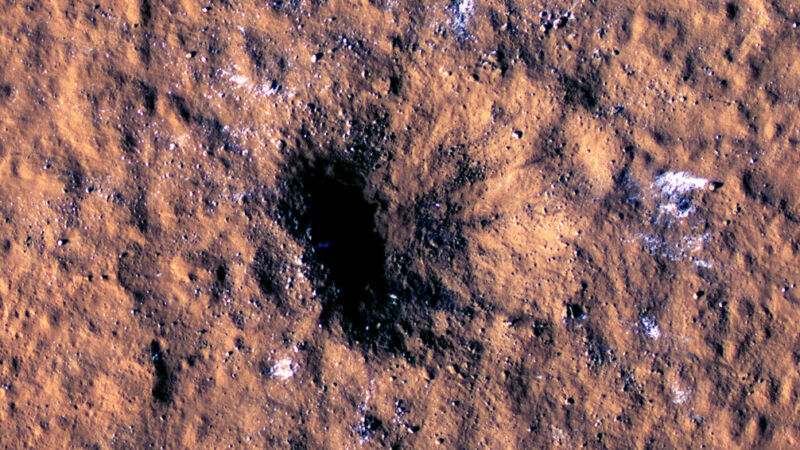
[ad_1]

Earth has earthquakes. Mars has marsquakes. There is only one distinction: marsquakes are most ceaselessly brought on by meteoroid crashes because the Purple Planet lacks the tectonic plates that shift items of crust on Earth. So what precipitated essentially the most intense marsquake ever when there was no proof of a collision?
Vibrations from the 4.7 magnitude quake despatched tremors by the Martian crust for six hours (if no more) and had been captured by NASA’s InSight lander in Could 2022. In any other case generally known as S1222a, this marsquake was assumed to have been brought on by a meteoroid impression, so a global staff of researchers instantly started looking for proof of a contemporary crater. The issue was that none existed. That is when the staff, led by planetary geophysicist Benjamin Fernando, started pondering that one thing was probably happening beneath the floor.
“We undertook a complete search of the area wherein the marsquake occurred,” Fernando and his staff stated in a research not too long ago revealed in Geophysical Analysis Letters. “We didn’t establish any contemporary craters within the space, implying that the marsquake was seemingly brought on by geological processes.”
An invisible offender
There would have been virtually no method to miss the hypothetical crater left within the wake of S1222a if one was really there. The researchers estimated that it might have needed to be a minimum of 300 meters (about 1,000 ft) in diameter.
InSight had beforehand recognized eight marsquakes brought on by impacts, the most important two being 150 meters (500 ft) in diameter every. There have been similarities between these and S1222a, as these had been the one three occasions for which seismic waves had been recognized on the floor. The waves additionally lasted for prolonged durations, as much as 10.5 hours for S1222a. One other factor all three occasions shared was power that spanned a broader vary of frequencies than different marsquakes. It appeared that these had been indicators of one other impression quake—however wait.
Regardless of the similarities that appeared to level to a meteorite faceplanting on Mars, there have been apparent variations the staff couldn’t ignore. The magnitude of S1222a far surpassed the opposite two quakes it was much like, and a larger number of seismic waves got here out of this quake than both of the others.
Nonetheless, Fernando and his colleagues determined to seek for an impression crater. The craters from each earlier occasions had been surrounded by darker blast zones that might be seen even in low-resolution photographs from the Mars Reconnaissance Orbiter’s MARCI (Mars Shade Imager) instrument. There was little doubt {that a} crater from S1222a would have needed to have a fair bigger blast zone. Besides there was no crater or blast zone to be seen.
If S1222a had been brought on by an impression and a crater had shaped, the scientists got here to the conclusion that certainly one of two issues have to be true. The crater might need been too small for it or its blast zone to be imaged by present devices. Alternately, it might have shaped on part of the floor with particularly unusual topography that made it troublesome to see or didn’t have a lot mud. However Mars is a dusty planet, and the low-dust speculation might be dominated out as a result of S1222a was localized to a area coated with reddish mud. Even medium and high-resolution photographs from numerous spacecraft confirmed no craters or blast zones that might match one thing created by S1222a.
Beneath the floor
If the perpetrator wasn’t an area rock, what might have presumably precipitated the most important recognized marsquake? Within the absence of a large crater, blast zone, or mud clouds that would have presumably matched the magnitude of S1222a, the staff lastly got here to the conclusion that subsurface forces should have been behind the quake.
“The one clarification which is per present observations is a subsurface tectonic supply,” they stated in the identical research.
However how might there be a geological supply with out tectonic plates on Mars? Tectonic forces will be generated by something that has a sizeable impact on the crust of a planet, not simply the sliding plates that trigger phenomena resembling quakes and volcanoes on Earth. Fernando means that S1222a is presumably the results of the Martian crust present process immense stress from cooling and shrinking for billions of years.
These processes don’t all occur evenly throughout the complete planet. Completely different areas might endure adjustments at completely different instances, and why some areas of Mars are extra careworn than others is a thriller that scientists proceed to analyze.
Tectonic forces on an alien planet could also be drastically completely different than these on Earth, however at the very least the prime suspect thought to have precipitated S1222a is now dominated out. Future spacecraft with much more seismic wave detection energy than InSight might regularly inform us what is occurring beneath that pink, rocky, sun-blasted floor.
Geophysical Analysis Letters, 2023. DOI: 10.1029/2023GL103619.
[ad_2]
Supply hyperlink